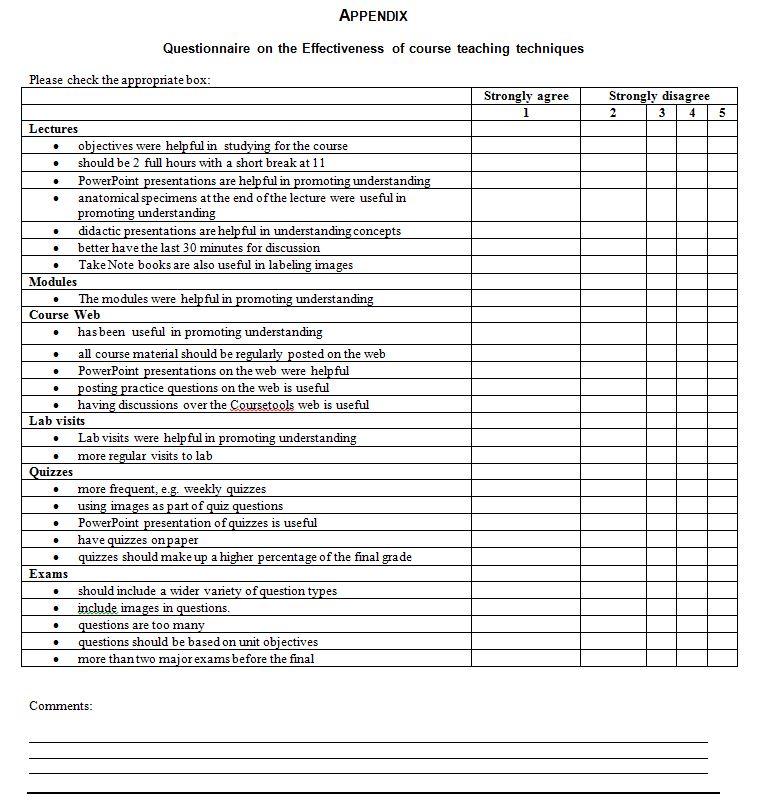Abstract
A challenge of the undergraduate anatomy course at the University of Michigan Medical School is the diverse educational background of students taking the course. Students taking this course belong to kinesiology, Literature, Science & Arts, dental hygiene, biomedical engineering, and pre-pharmacology and other graduate disciplines. Questionable motivation and poor course performance of more than 50% of our students caused us to introduce innovative teaching measures during the Fall 2002 semester. These measures included: 1) regular quizzes, 2) frequent visits to the gross anatomy lab, 3) specific lecture objectives handed out before lectures, 4) PowerPoint® lecture presentations that sometimes included animations of basic anatomical concepts, 5) a “Coursetools” web site that contained lecture objectives and presentations, schedules, announcements, and a discussion forum, and 6) mandatory modules that utilized plastinated specimens and covered essential course concepts. Student questionnaires were administered and analyzed to evaluate the effectiveness of these methods. The aim of introducing survey questionnaires during the semester was to focus attention on specific emerging issues that needed prompt management during the course. Results showed that the majority of students favored the weekly quizzes, lab visits, PowerPoint presentations, and lecture objectives. Also, there was a statistically significant improvement in students’ performance from all disciplines during the final examination compared to the first and second examinations following the introduction of the measures. Although these teaching techniques have not significantly raised students’ mean performance in relation to previous years, the results showed that they were welcomed by the majority of students and that performance was positively enhanced. These measures will be re-implemented during the next semester and their effectiveness further evaluated.
Introduction
The Division of Anatomical Sciences at the University of Michigan Medical School offers an annual anatomy course for undergraduate students in different academic programs. This is a required lecture-based course offered during the Fall semester that has an average annual enrollment size of about 150 students from five academic areas: 1) Kinesiology (35%), 2) Literature Science and Arts (LS&A) (25%), 3) Dental Hygiene (20%), 4) Biomedical Engineering (BME) (10%), and 5) other disciplines (Others) (10%). Former course assessment was based on three multiple-choice-question exams including the final. The first exam covered the first month’s material that dealt with the general organization of the human body and the musculoskeletal system. The second exam covered the control and integration systems, and the final exam covered the remaining major systems and had 20% of its questions from earlier sessions.
A persistent and critical challenge is the diverse educational background of students taking the course. This issue is reflected on the students’ perception of the course’s relevance to their future careers. Many students consider anatomy merely a prerequisite for their graduate studies.1 For several years it has been noticed that this matter has adversely affected the course performance of more than 50% of the students, particularly those students in the dental hygiene and kinesiology programs.
New teaching measures were introduced during the Fall semester of 2002 to address this issue and to re-emphasize the course’s goal of acquainting students with the essential and integrated anatomical facts that will be useful in their studies, careers and everyday life. The teaching methods employed in this study were based on published data that students’ performance and interest could be enhanced with: 1) ongoing means of assessment,1,2 2) the initial provision of lecture objectives,2,3 3) the introduction of sufficient opportunities for students to interact with faculty and discuss concerns,3,4 4) the provision of interactive web-based tools for learning,5 5) the reinforcing of relevance through lab visits and modules.6
Materials and Methods
Many of the new measures were implemented at the beginning of the course. These included: periodic quizzes, usage of plastinated anatomical specimens, frequent lab visits, three required learning modules, PowerPoint lecture presentations, and a course web page.
Quizzes were administered periodically to encourage both attendance and preparation. These quizzes were administered in PowerPoint format. Students answered on “scantron” computer forms, which allowed each quiz to be graded by the following day. This method permitted quick feedback to students and availability of the item analysis output.
Plastinated anatomical specimens were used during each lecture. Students were given the opportunity to closely examine them afterwards. Also, students were given the opportunity to familiarize themselves with pertinent plastinated material during frequent visits to the gross anatomy lab. Four visits to the gross anatomy lab were arranged. Plastinated specimens were displayed and faculty members were available to assist students in understanding the relevant anatomical and clinical knowledge.
Throughout the semester three learning modules were assigned which covered essential course concepts and utilized plastinated specimens. Each module consisted of a plastinated organ or joint and instructions with illustrations explaining its required anatomical features. Students were encouraged to review these modules in groups to facilitate discussion and understanding. PowerPoint presentations were created to accompany each lecture. These presentations often included animations of basic anatomical concepts.
A “Coursetools” interactive web page was created. It allowed students a twenty-four hour access to lecture objectives, PowerPoint presentations, schedules, announcements, and provided a discussion forum to facilitate communication amongst students and faculty.
Directly following the first course examination, an informal meeting was scheduled with a representative group of students to address their concerns surrounding test performance. Forty-five students, approximately one third of those enrolled in the course, volunteered and met to discuss the new measures. This provided a forum for direct communication with those students most concerned with the course’s structure and teaching methods. Consequently, the following measures were also implemented as a result of the meeting: 1) specific lecture objectives were prepared and distributed to students, occasionally, quiz and exam questions were based on those objectives, and 2) more quizzes were added to continue with the weekly pattern through the end of the semester.
Two identical questionnaires (Q1and Q2), administered after the first and second exams focused exclusively on our testing techniques. The questions centered on the relevance of examinations to lecture objectives and physical testing boundaries (i.e. exam length and time). A third questionnaire (Q3) administered at the midpoint of the course (immediately before exam two) contained 25 questions that surveyed the broad array of new measures implemented in this investigation. Questions were organized into the following categories: improving the lecture, usefulness of the learning modules, course web evaluation, laboratory visits, class quizzes, and exam structure. The value of course web material and the desired frequency of lab visits were investigated for their overall effect on the learning process.
A fourth questionnaire (Q4) was administered during the final exam and further examined the issues described in the mid-point survey (Q3). Students were again asked to respond to the usefulness of the new teaching methods.
All student responses were evaluated using a five-point Likert scale and analyzed using the Statistical Package for Social Sciences software (SPSS version 6.1 for Mac). In tabulating the responses the scale was reduced to three points for the sake of simplicity. Mean responses to each question from all surveys were calculated and analyzed. Each new measure could then be considered using its relative approval as evaluated anonymously by the students. The first, second and final exam scores in all five disciplines were assessed by a multivariate analysis of variance with repeated measures. These analyses examined the magnitude of improvement in performance over the three exams. Analysis of variance (F ratio p <.05) and Duncan’s Multiple Range Test (global alpha=.05) were used to determine differences in students’ performance in the five disciplines.
Each questionnaire also contained a written “Comments” section that gave students an opportunity to communicate other course-related issues.
Results
The response rate to the questionnaire about the new measures (Q3) was 83% (N=143). The majority of students favored lecture objectives (80%), PowerPoint presentation of lectures (64%), posting PowerPoint presentations on the course’s web (75%); weekly quizzes (71%); exams to be based on lecture objectives (89%), lab visits (60%), and the learning modules (60%). Around half of the students favored didactic presentations (49%), the use of anatomical specimens (56%), PowerPoint presentation of quizzes (58%), including images and diagrams in quizzes and exams (56%), more than two exams during the semester (53%), and more regular lab visits (55%) (Table 1). Likewise, the final exam questionnaire (Q4) showed similar responses from students (Figure 1).
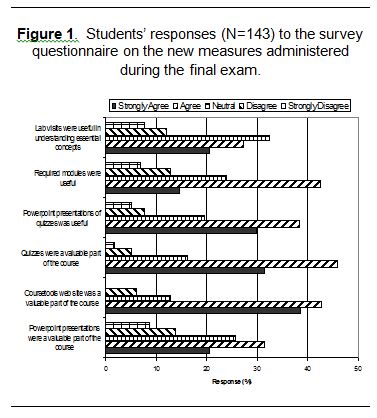
The response rate to both exam questionnaires (Q1 and Q2) was 86% (N=143). Table 2 shows a significant improvement in student satisfaction with the exam following the implementation of the new measures. Feedback from the exam one questionnaire (Q1) indicated that one-third of students did not feel that the exam covered material from lectures, textbook or syllabus. Moreover, nearly half of the students disagreed with the statement that their exam performance was reflective of their overall preparation efforts. The average grade of the first examination was 72.6%.
The same questionnaire was administered to all students after the second exam (Q2). When asked about relevance of exam questions to course material, readings and the syllabus, only 4% of students disagreed with these questions. More than half of the students agreed that their performance was reflective of their overall efforts, while only 25% disagreed and the remainder gave a neutral response (Table 2). The improvement in second exam mean performance (76.5%) compared to that of the first exam (72.6%) was statistically significant. In general, feedback from this questionnaire was more positive on almost all issues.
There were no noteworthy differences between agreement and disagreement in the questions regarding exam length, question clarity, time, and candor of the questions for both exams. The average score of the final examination was 80.2%.
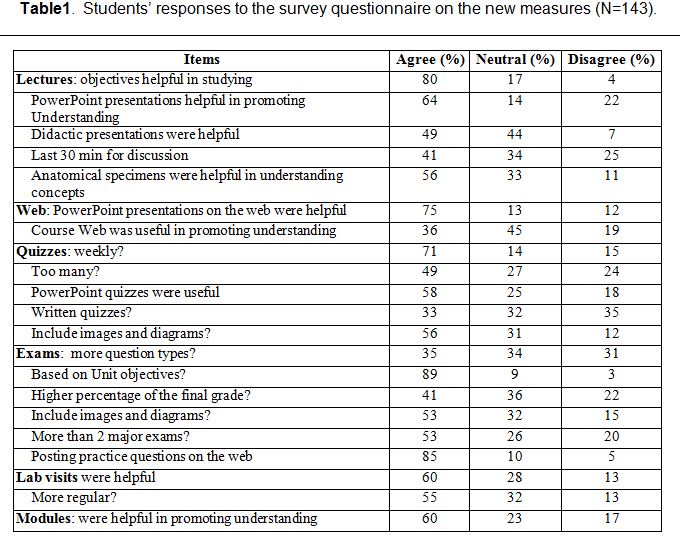
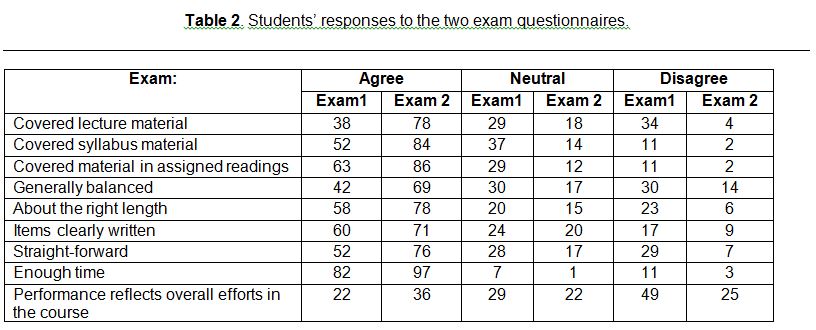
The first, second and final exam scores in all five disciplines were assessed by a multivariate analysis of variance with repeated measures. These analyses examined the magnitude of improvement in performance over the three exams. Results showed that there had been a significant improvement in students’ performance in all five disciplines (Table 3).
Analysis of variance (F ratio p <.05) and Duncan’s Multiple Range Test (global alpha=.05) of the final course’s grades revealed significant differences in students’ performance in the five disciplines. Dental hygiene students’ performance was significantly different from that of the remaining four disciplines. Kinesiology students’ performance was significantly different from that of BME and Others students. However, there was no significant difference between students’ performance in the BME, LS&A and Others disciplines. Similar statistical procedures applied to the previous four years scores had confirmed the lower grades of the dental hygiene students but did not show consistent and conclusive differences in performance among the remaining four disciplines.
The class’s mean final cumulative grade was 78.08 (SD ±13.59), while that of the previous four years combined was 77.13 (SD ±10.75). The difference in both scores was statistically insignificant.
A broad array of opinions was expressed by students in the “Comments” sections of questionnaires. Most of the comments emphasized responses to questionnaire items. The class meeting held immediately after the first exam was welcomed by many students as a positive approach that allowed them to interact with faculty, express concerns, and receive feedback on improving their study habits.
Discussion
A common predicament associated with undergraduate anatomy courses is the large number of students with diverse educational backgrounds.1An important issue with many undergraduate anatomy courses is that they are usually lecture-based without an opportunity to reinforce content in a laboratory setting.7
The issues of academic heterogeneity among undergraduate students and the absence of anatomy labs were recognized in the undergraduate anatomy course offered at the University of Michigan Medical School. The diverse academic backgrounds of students has been reported to affect motivation for learning anatomy, thus many students consider anatomy merely a prerequisite for their graduate studies.1 This is usually reflected unfavorably on their course performance, a known outcome that has been observed over a long period of time.
The instructional techniques that we introduced in the 2002 Fall semester in our anatomy course were intended to improve students’ conceptual understanding and performance in anatomy. This is based on the concept that students’ performance could be enhanced with frequent quizzing,1,2 the provision of lecture objectives,2,3 sufficient opportunities for students to interact with faculty and discuss concerns,3,4 interactive web-based tools for learning,5 and by reinforcing relevance through lab visits and learning modules.6
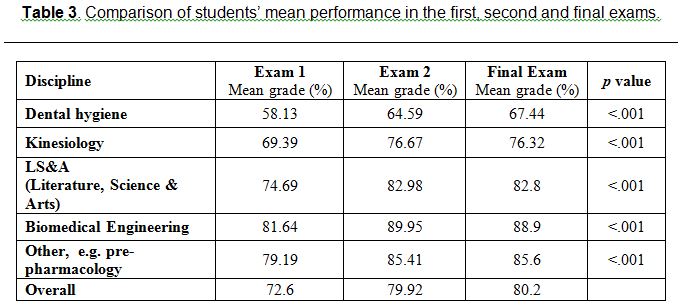
In this study, the majority of students agreed that the lecture objectives were useful (80%); weekly quizzes (71%); and posting the PowerPoint lectures presentations on the course’s web (75%) reflected a significant satisfaction with these techniques (Table 1, Figure 1). Students were more content with course exams following the introduction of these measures (Table 2). The statistically significant improvement of the entire class exam performance and in each of the five different discipline groups (Table 3) reflected an objective benchmark for the effectiveness of these measures.
The significant differences in students’ performance in the five disciplines proved by the Analysis of variance reflect an interesting finding. We think that this could be attributed to several factors that warrant investigation. These include: 1) the diverse academic level of students, the BME students are usually at the graduate level and hence are more experienced, while most of the dental hygiene and some of the kinesiology students are either in the freshman or sophomore levels, and 2) students differ in their prospective plans in taking this course. Dental hygiene and pre-pharmacology students (Others) take the course as a prerequisite and apparently are more concerned on attaining a mere passing grade. Students in the BME and many in the LS&A and kinesiology programs plan to start a more competitive career or apply to a medical school. They usually study hard to earn a high score and to understand anatomy for future relevance to medical study.
Comparison of the mean class performance during the past four years with that of Fall 2002 showed an improved trend that was not statistically significant. Nevertheless, such an outcome represents a modest initial success in implementing these techniques.
Plans have already been started in refining the application of these techniques. These include the early provision of lecture objectives, improving the course’s web material, and introducing more structured lab visits and modules. Moreover, an exam bank that is based on item analyzed data that would be more effective in assessing students’ comprehension is being established.
The initial positive outcome of this study encourages us to invest more effort in developing the new measures and in evaluating their effect on stimulating students’ awareness in learning anatomy. The approach described here in addressing the issues of students’ motivation and performance in anatomy could be utilized by other institutions offering similar courses. We hope that it will contribute to the general efforts aiming to enhance the effectiveness of anatomy instruction and facilitate learning.
References
- Fox, M.A. & Hackerman, N. Evaluating and Improving Undergraduate Teaching in Science, Technology, Engineering, and Mathematics. The National Academies Press, Washington, D.C. 2003; 25-40.
- Mennin, S. & Kalishman, S. Student Assessment. Academic Medicine 1998; 73 (9); S46-S54.
- Distlehorst, L., Dunnington, G.L., & Folse, J.R. Teaching and Learning in Medical and Surgical Education. Lawrence Erlbaum Associates, USA 2000; 51-69.
- Shatzer, J.H. Instructional Methods. Academic Medicine 1998; 73(9); S38-S45.
- Hallgren, R.C., Parkhurst, P.E., Monson, C.L., & Crewe, N.M. An interactive, web-based tool for learning anatomic landmarks. Academic Medicine; 2002; 77(3): 263-265.
- Aziz, M.A., McKenzie, J.C., Wilson, J.S., Cowie, R.J., Ayeni, S.A., & Dunn, B.K. The human cadaver in the age of biomedical informatics. The Anatomical Record 2002; 269:20-32.
- Dyer, G.S.M. & Thorndike, M.E.L. Quinte Mortui Vivos Docent? The Evolving Purpose of Human Dissection in Medical Education. Academic Medicine 2000; 75(10): 969-988.
APPENDIX
